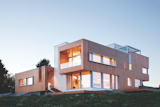5 Stunning Uses of Western Red Cedar
Mention Western Red Cedar wood as a building material, and many people may conjure up images of rustic cabins tucked into the woods. But while the material is certainly at home in nature—literally and figuratively—it’s becoming increasingly popular as a versatile option for modern design. The material is extremely adaptable due to its warmth, durability, and affordability. Beyond that, the wood’s aesthetic suits a variety of projects. In some cases it sets a dramatic stage for the entire structure; in others, it acts as a statement piece. Below, we look at five structures that were featured in Cedar Book X and Cedar XI, the annual architectural publication produced by the Western Red Cedar Lumber Association (WRCLA).
The Karuna House
Strike any thought of a rustic cabin from your mind, Western Red Cedar compliments even the most modern design. When building his family residence in Newberg, Oregon, Eric Lemelson had high standards for his contemporary structure. In order to complement the home’s clean, modern lines, the family opted for a building material that would add depth and texture to the home’s other building materials, largely glass and concrete. "Western Red Cedar’s texture reflects the project’s natural surroundings," says Cory Hawbecker, a sustainability expert from Holst Architecture, the group that designed the home. The Lemelsons were pleased with the finished product: a contemporary, wood and glass home—one that stands out yet nestles right in to the hillside of Newberg, Oregon.
The Hilltop House
Before building their family home, the owners of the Hilltop House lived on their Niagara Escarpment property for a month to study how the wind and sun moved along the land. They were then able to capitalize on the natural movement of light and air in the design of their home. The resulting house is an energy-saving, wooden building that integrates the landscape effortlessly. In keeping with the family’s desire for a sustainable home, architects at Atelier Kastelic Buffey (AKB) opted for Western Red Cedar for the home’s siding, decking, and ceiling. The eco friendly cedar products are renewable, biodegradable, and naturally reduces greenhouse gases. WRC is responsibly harvested from certified, sustainably managed forests, and being so lightweight, the wood is easy to transport, thus reducing its carbon footprint. These factors make Western Red Cedar one of the most environmentally conscious materials available.
The Courtyard House
When architect Robert Hutchinson suggested to a client that they stain the Western Red Cedar siding of their residential home black, the client was suspect. But Hutchinson was persuasive. "As soon as the facade was completed, they immediately called me saying, ‘Oh my gosh, the building almost disappears into the forest!’" Western Red Cedar was the perfect palette for this type of semi-transparent stain. The wood, which is pitch and resin free, accepts and holds any type of wood finish beautifully. The black stain is striking and bold, grabbing the eye while somehow blending in with the natural environment.
The Sea Bright House
Located on the coast of New Jersey, the Sea Bright House boasts stunning views. It also endures a damp sea breeze and chilly weather, given the time of year. Architect Jeff Jordan went with Western Red Cedar not only for its warm and familiar appearance, but also because it withstands the elements. Western Red Cedar naturally resists rot, decay, and insects. Jordan also chose to leave the wood unfinished, a prominent part of the house’s look. "It would have been difficult to find another material that has both a natural appearance and can weather naturally over time," says Jordan. The low maintenance material handles the weather beautifully year after year, and left unfinished, gains a beautiful, signature silver-gray patina.
The Skyline House
When he designed the Skyline House, a family home overlooking the San Francisco Bay, architect Ivan Terry was determined to prioritize the stunning views. He crafted a "wood tube" that allows for front to back views of the bay and surrounding hills. The form of the tube echoes the wisps of fog that hug the coastline: a wavy Western Red Cedar ceiling that proves to be a show-stopper. "The cedar is flexible in the flat direction," explains Terry, noting that the wood is not only beautiful, but surprisingly lightweight and easy to work with, making it the perfect material for the concave to convex ceiling.
Durable and lightweight, weather resistant and eco-friendly, Western Red Cedar’s versatility and reliability make it a compelling building material. Add to that the wood’s natural beauty—no matter the finish—it’s no surprise it’s showing up again and again in diverse and unique projects.
Each year, WRCLA produces an annual Cedar Book, chronicling beautiful projects and their unique use of Western Red Cedar. Draw inspiration from the Cedar Books for your next project.
Published
Last Updated
Get the Dwell Newsletter
Be the first to see our latest home tours, design news, and more.















